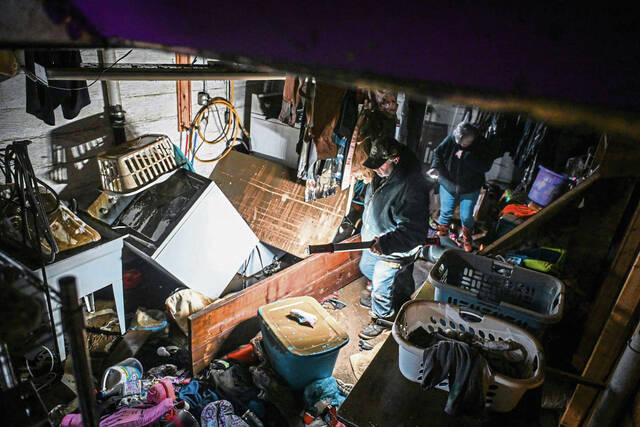Westmoreland flood damage may not be bad enough for disaster declaration
As bad as the flood was for some Westmoreland County residents whose appliances, furnaces and other items in their basements were ruined by flood waters Wednesday, the losses may not rise to the level needed to be declared a disaster, which releases government aid, a county official said Friday.
“Westmoreland County alone doesn’t have the severity (of damage) to reach the threshold for some type of disaster declaration,” said Roland “Buddy” Mertz, director of the Westmoreland County Department of Public Safety.
County officials met Friday with emergency management coordinators in Sutersville, Sewickley Township and West Newton to assess the flood damages, Mertz said. The public safety department also received initial assessments from emergency management agencies at other municipalities.
“They had a lot of flooded basements and some houses that had first-floor damage,” he said.
The county will compile those assessments and place them into a state database, Mertz said.
Michael Manley, Sewickley Township’s emergency management coordinator, said he didn’t believe the damages to homes in the municipality rose to the level that would justify a disaster declaration.
Only one house in Sewickley Township sustained damage on the first floor — which is part of the criteria used in determining whether to make a disaster declaration, Manley said. Several homes along Lowber Road had flooded basements from Sewickley Creek and one had water reach a few inches about the floor of the first floor.
Manley, who is assistant chief with the Sutersville fire department, said he gave the county his damage assessments.
What a ‘disaster’ entails
To have the state consider a municipality a disaster area, Mertz said that at least 25 homes must have had water reach the living space of the house, the and the owners have to sustain an uninsured loss greater than 40%. At least five businesses that suffer an uninsured loss of 40% or more may be considered for a disaster declaration.
If there is that much damage and uninsured losses, the county would petition the state for assistance through the federal Small Business Administration, which provides low-interest loans to residents and business owners, Mertz said. The county’s request for a disaster declaration would trigger another round of damage assessments by the state and approval by the governor, before any disaster declaration could be sent onto Washington, D.C.
In the meantime, Mertz said the American Red Cross is helping flood victims with cleaning supplies and the county is working with the Westmoreland County Human Services and Preparedness Coalition to help flood victims recover. The coalition is composed of representatives from public, private, government and nonprofits.
Perfect storm
A “perfect storm” of factors converged this week to help exacerbate the severity of the storm a Westmoreland County hydrologist said.
Across the watershed, there are a lot of highways and commercial development without any stormwater management, said James Pillsbury, the hydrologist for the Westmoreland County Conservation District in Hempfield.
Rains that totaled between 4 inches and 5 inches fell across the 168-square-mile Sewickley Creek watershed, flowed down though the village of Lowber before reaching the Youghiogheny River.
Residential development built before the new rules on stormwater management don’t have retention ponds to hold runoff during a storm, Pillsbury said.
And the cooler temperatures in early April were no help, either. Pillsbury said the water that did fall and reach the streams was not subjected to evaporation, as might have happened in the summer.
The trees and other vegetation that are dormant this time of year, didn’t help curb the absorption of the water through “evapotranspiration,” Pillsbury said. That process moves the water from the soil into plants and other vegetation, which is then released as water vapor into the air from their leaves, according to the U.S. Geological Survey.
And for those who have lived through what might be termed a once in 25-year flood, “there’s no guarantee it won’t happen again,” Pillsbury said.
‘Balancing act’
The storms that fed the streams in Fayette and Somerset counties and western Maryland that pour into the 16-mile-long Yough River Lake at Confluence pushed the level of the lake up 17 feet this past week, said Nick Lazzaro, who oversees the water management at the Army Corps of Engineers’ dams in the wide-ranging Pittsburgh district.
That created challenges for Lazzaro and the Corps.
Releasing more water from the dam at Confluence meant more water rushing past river towns like Confluence, Connellsville, Jacobs Creek, West Newton and Sutersville, before pouring into the Monongahela River at McKeesport. Holding back more water at the dam can risk flooding roads, bridges and communities in Garrett County, Md.
“It’s a balancing act,” Lazzaro said. “It does impact your decision for releasing the water (from the dam),” Lazzaro said.
In making those decisions about how much water should be released through the underwater pipes, the Corps uses computer software and monitors the river levels at the towns downstream, Lazzaro said. Both Connellsville and Sutersville have river gauges that can be tracked on the National Oceanic and Atmospheric Administration’s National Weather Service website.
“We reduced it (water release) as much as possible,” Lazzaro said, while maintaining a safe level behind the dam.
Joe Napsha is a TribLive reporter covering Irwin, North Huntingdon and the Norwin School District. He also writes about business issues. He grew up on Neville Island and has worked at the Trib since the early 1980s. He can be reached at jnapsha@triblive.com.
Remove the ads from your TribLIVE reading experience but still support the journalists who create the content with TribLIVE Ad-Free.

